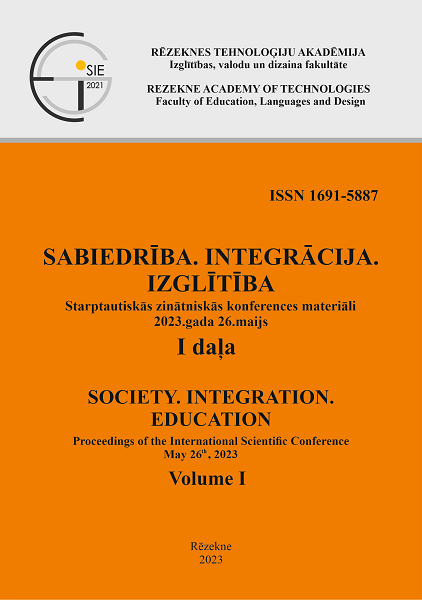POSSIBILITIES OF INCLUSION OF NEWCOMERS IN GENERAL SCHOOLS OF LATVIA
DOI:
https://doi.org/10.17770/sie2023vol1.7150Keywords:
general school, inclusion, newcomersAbstract
At the time when Russia is conducting military operations in Ukraine, Latvia provides all possible political, financial, military and humanitarian support to Ukraine, including hosting Ukrainian residents fleeing the war in Latvia. Education plays a vital role in the economic, social and cultural integration of migrants and refugees in the host country. Education is a key tool for transitioning from humanitarian to development and integrating those granted asylum into society. The aim of study: to study the possibilities and threats of inclusion of newcomers in general education schools and to analyze the experience of students included in general education schools of the city of Rēzekne and Rēzekne district.
References
Correa-Velez, I., Giford, S. M., & Barnett, A. G. (2010). Longing to belong: Social inclusion and wellbeing among youth with refugee backgrounds in the frst three years in Melbourne Australia. Social Science & Medicine, 71(8), 1399–1408. DOI: https://doi.org/10.1016/j.socscimed.2010.07.018
Crul, M., Keskiner, E., Schneider, J., Lelie, F., & Ghaeminia, S. (2016). No lost generation? Education for refugee children. A comparison between Sweden, Germany, The Netherlands and Turkey. In R. Bauböck & M. Tripkovic (Eds.), The integration of migrants and refugees (pp. 62–79). European University Institute. Retrieved from: https://op.europa.eu/en/publication-detail/-/publication/d68aa615-5bdd-11e7-954d-01aa75ed71a1
Crul, M., Lelie, F., Biner, Ö., Bunar, N., Keskiner, E., Kokkali, I., Schneider, J., & Shuayb, M. (2019). How the diferent policies and school systems afect the inclusion of Syrian refugee children in Sweden, Germany Greece Lebanon and Turkey. Comparative Migration Studies, 7(1), 10. DOI: https://doi.org/10.1186/s40878-018-0110-6
Dusik, C. L., & Santarosa, L. M. C. (2016). Mousekey syllabic virtual keyboard: An assistive technology tool for people with physical disabilities. In M.J. Marcelino, A.J. Mendes, & M.C.A. Gomes (Eds.), ICT in education multiple and inclusive perspectives (pp.171-197). Springer.
Edele, A., Kristen, C., Stanat, P., & Will, G. (Hrsg.) (2021). The education of recently arrived refugees in Germany: conditions, processes, and outcomes. Journal of Educational Research Online, 13(1). DOI: https://doi.org/10.25656/01:22064
European Commission. (2020). EU Action plan on Integration and Inclusion 2021-2027. Retrieved from: https://ec.europa.eu/migrant-integration/news/ec-reveals-its-new-eu-action-plan-integration-and-inclusion-2021-2027_en
Hilt, L. T. (2017). Education without a shared language: Dynamics of inclusion and exclusion in Norwegian introductory classes for newly arrived minority language students. International Journal of Inclusive Education, 21(6), 585–601. DOI: https://doi.org/10.1080/13603116.2016.1223179
International Bank for Reconstruction and Development / The World Bank. (2021). The Global Cost of Inclusive Refugee Education. A joint World Bank-UNHCR report. Retrieved from: https://www.unhcr.org/6038d7724.pdf
Liasidou, A. (2015). Inclusive education and the ıssue of change. Theory, policy and pedagogy. Palgrave Macmillan.
LR Saeima. (1998). Izglītības likums. Pieejams: http://likumi.lv/doc.php?id=50759
LR Saeima. (2016). Patvēruma likums. Pieejams: https://likumi.lv/ta/id/278986-patveruma-likums
LR Saeima. (2022). Ukrainas civiliedzīvotāju atbalsta likums. Pieejams: https://likumi.lv/ta/id/330546-ukrainas-civiliedzivotaju-atbalsta-likums
Miles, J., & McKenna, M. C. B. (2016). Giving refugee students a strong head start: The LEAD Program. TESL Canada Journal, 33(10), pp. 109-128. DOI: doi:1018806/tesl.v33i0.1248
Nacionālā enciklopēdija. (2022). Iekļaujoša izglītība. Pieejams: https://enciklopedija.lv/skirklis/157512-iek%C4%BCaujo%C5%A1%C4%81-izgl%C4%ABt%C4%ABba
Nayir, F., & Saridas, G. (2021). The adaptation of newly arrived immigrant students to education: evidence from Turkey. Psycho-Educational Research Reviews, Vol 10, no.2, pp. 213-229. Retrieved from: https://www.researchgate.net/publication/353681300_THE_ADAPTATION_OF_NEWLY_ARRIVED_IMMIGRANT_STUDENTS_TO_EDUCATION_EVIDENCE_FROM_TURKEY
OECD. (2005). Teachers matters. Attracting, developing and retaining effective teachers. Retrieved from: https://www.oecd.org/education/school/34990905.pdf
Puķe, I. (2022). Cerībā drīzumā atgriezties mājās daļa Ukrainas bēgļu bērnu mācās divtik – gan Latvijas kolā, gan tālmācībā Ukrainā. Latvijas Sabiedriskie mediji. Pieejams: https://www.lsm.lv/raksts/zinas/latvija/ceriba-drizuma-atgriezties-majas-dala-ukrainas-beglu-bernu-macas-divtik--gan-latvijas-skola-gan-talmaciba-ukraina.a475942/
Puri, M., & Abraham, G. (2004). Why inclusion? In M. Puri, & G. Abraham (Eds), Handbook of inclusive education for educators, administrators, and planners. within walls, without boundaries (pp. 22-27). SAGE Publications. Retrieved from: https://www.thefreelibrary.com/Madhumita+Puri+and+George+Abraham+(eds.).+Handbook+of+Inclusive...-a0202562090
Short, D. J., & Boyson, B. A. (2012). Helping newcomer students succeed in secondary schools and beyond. Center for Applied Linguistics. Retrieved from: https://www.cal.org/resource-center/publications-products/helping-newcomer-students
Tajic, D., & Bunar, N. (2020). Do both ‘get it right’? Inclusion of newly arrived migrant students in Swedish primary schools. International Journal of Inclusive Education, 1-15. DOI: https://doi.org/10. 1080/13603116.2020.1841838
UNESCO. (2018). Global education monitoring report 2019: Migration, displacement and education: building bridges, not walls. Retrieved from: https://unesdoc.unesco.org/ark:/48223/pf0000366946
VIIS. (2022). Aktuāli izglītības dati. Pieejams: https://www.viis.gov.lv/
Vogel, D., & Stock, E. (2017). Opportunities and hope through education: How German schools include refugees. Gewerkschaft für Erziehung und Wissenschaft (GEW). Retrieved from: https://www.gew.de/index.php?eID=dumpFile&t=f&f=64713&token=f1083303641e3d2100203df9b5ce79613f498e49&sdownload=&n=Opportunities_and_Hope_through_Education_How_German_Schools_Include_Refugees.pdf
Woods, A. (2009). Learning to be literate: Issues of pedagogy for recently arrived refugee youth in Australia. Critical Inquiry in Language Studies, 6(1–2), 81–101. DOI: https://doi.org/10.1080/1542758080 2679468.
Yilmaz, R. K., & Yeganeh, E. (2021). Who and How Do I Include? A Case Study on Teachers’ Inclusive Education Practices. International Journal of Progressive Education, Volume 17, Number 2. DOI: 10.29329/ijpe.2020.332.25






